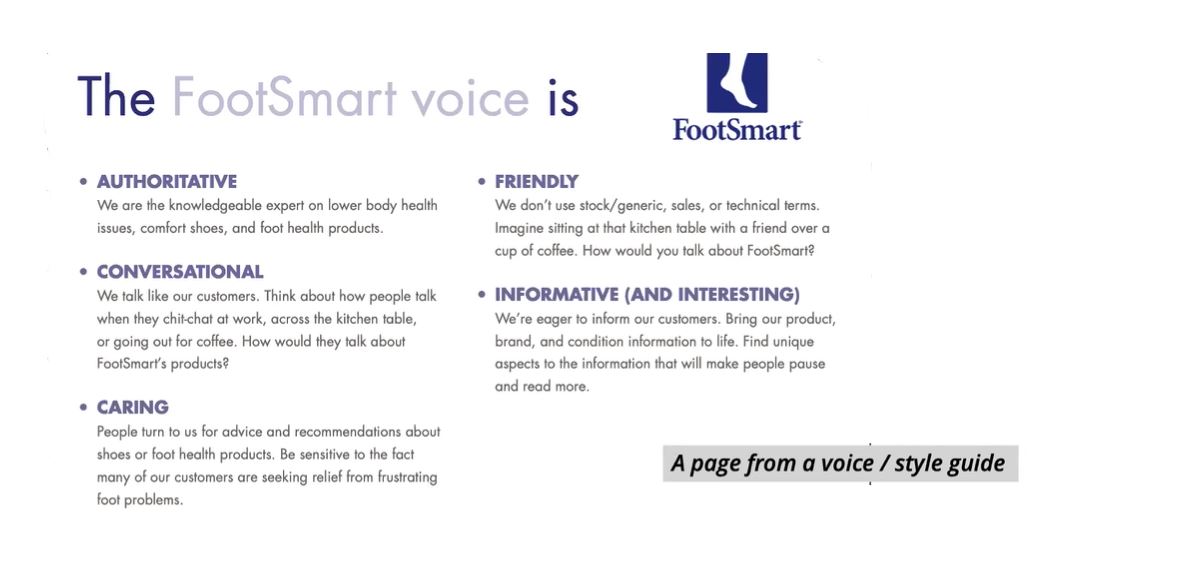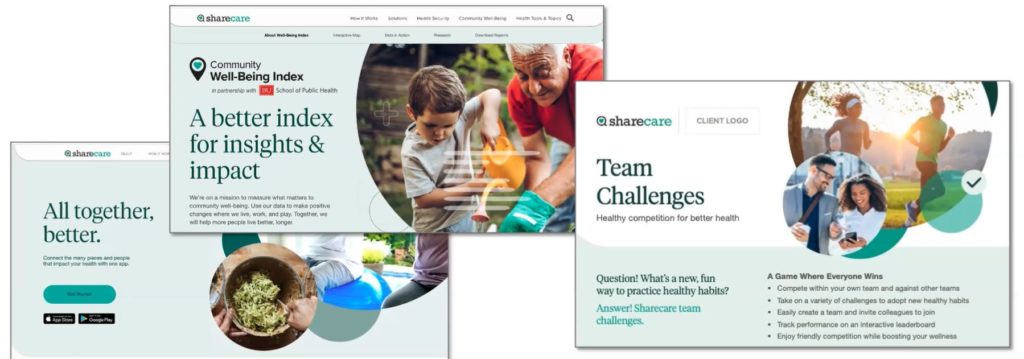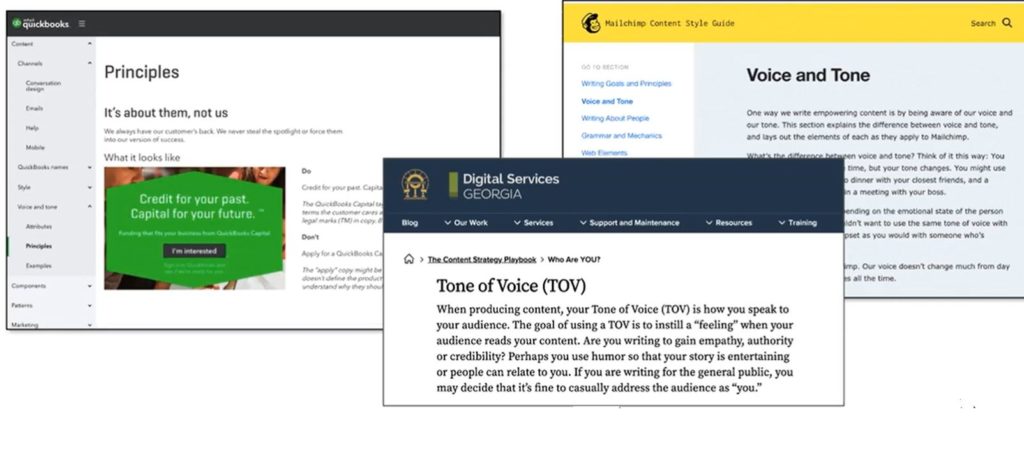
Content voice is essential to building long-term relationships with your users. A disjointed voice can turn off or confuse users, while a consistent voice and tone establish trust. But developing your voice is just one step toward consistency. You still have to socialize your voice to get alignment and to scale its use throughout your organization.
What Content Voice Is
Does your organization or brand have a defined content voice? If your answer is no or you’re not sure, you may want to start with how we define content voice:
Your content voice is your verbal identity.
Just as logos and colors are part of your visual identity, voice is all of the elements of your verbal identity, including the style of language that you use and tone that you take on.
It’s like your digital fingerprint. It should be:
- Unique and recognizable
- Complementary to your visual identity
- Reflective of who you are
- Appealing to your customers or audience
Voice is the personality of your brand, and it should reflect your brand values.
Here is an example of a page from a voice/style guide that Content Science created for the health retail brand Footsmart. In it, you can see there are clear principles and key characteristics of the brand’s content voice. You can see how the information in the guide can translate easily to language choice and tone decisions.

Why Voice Is Crucial
Today, people rely on content in digital experiences for day-to-day life. And the evolution of digital has only accelerated with the pandemic. Many parts of our life now rely on long-term relationships with companies that are digital—and mediated through content. These can include subscriptions, repeat purchases,and ongoing commitments.
Customers or users expect the right content at the right time, regardless of channel—for the entire customer relationship. This constant content interaction means the voice in your content matters more now than ever before. Customers will notice if you sound one way in one channel and very different in another.
When and How To Revisit Your Voice
Even if you have a content voice established to a certain degree, it is essential that your voice is current.
1. Your voice should reflect who you are today
For example, the healthcare company Sharecare recently evolved its voice to reflect its maturity as a business after years of intense growth. When Content Science started working with Sharecare, their voice reflected a mix of all of the companies and brands that they had acquired over about 10 years. But as a leading digital health company and amid growing attention during the pandemic, Sharecare’s content voice disconnects became even more evident.
In updating their voice, Sharecare brought to life the key theme “All together, better.” And the company traded jargon for a more human and personable style.

2. Become a signal in the noise
You’re competing with more messages and content than ever before. Forrester has predicted that marketing message volume will go up 40% in 2021. And IDC has reported that the internet doubles in size every two years.
Your content competition can come from a variety of sources. Take the example of Intuit and Turbotax. Intuit realized a number of years ago that they were actually competing with the IRS. And, their voice and tone wasn’t really all that different from the government. So they started to shift their voice.
“We looked ourselves hard in the face and said, ‘Man, we’re like one step aware from the IRS.’ Our language was very credible, but it was very tax-y and we thought this is not easy for anyone to understand deductions and credits and schedule fees.”
– Kurt Walecki, VP, Intuit
The new icons and personable text made it feel as though a friend was guiding you step by step. Turbotax not only improved the experience for existing customers, but also gained a significant number of new customers.
3. Build trust through consistency and inclusion
To solidify credibility, think consistent, not formal—even for crucial topics. This is particularly important for high-stakes topics such as health and finance. Having a consistent content voice is one way to strengthen trust.
Blue Cross Blue Shield North Carolina has been doing a lot of work to present a more unified voice. They have established an entire initiative around it, called the One Voice Initiative. And the company sees these efforts are paying off:
“This year I predict that the hard work we are doing inside the organization will have a positive impact on our member’s experience. We know the health landscape is changing rapidly, and we know our members are looking to us to help them understand what they are covered for.”
– Stacey Martin, Blue Cross and Blue Shield of North Carolina
Another aspect of building trust is using inclusive language. Today, more and more users expect inclusive language and will be turned off if you don’t use it.
4. Take advantage of voice interfaces
More people than ever are using voice command search, listening to podcasts, and listening to audio versions of content. You will have an advantage in this space if your voice and tone are conversational and lend themselves to being found through casual questions. You will also have an advantage if your content is pleasant and compelling to listen to.
How Do I Start To Align and Scale Voice?
There are three factors that separate organizations succeeding in scaling their voice:
- How they define voice
- Their documentation
- What they do to enable voice
1. Define or redefine your core voice
As you do this, consider:
- What emotions do you want to convey or evoke?
- What personality characteristics will appeal to your customers or audience?
- What tone adjustments are appropriate for different contexts?
- Are you doing enough to be inclusive and accessible?
2. Update and tighten (or create) your documentation
The most successful organizations write down their strategy, style details, and more. With voice, it is really helpful to have a well-defined strategy because it can help everyone understand the context in which content will be used and how voice and tone can have an impact.

3. Enable your organization with education, governance, and technology
When it comes to voice, the most successful organizations:
- Have executive buy in
- Make stakeholders aware
- Train content teams and partners
- Set up accountability
- Use technology to help automate adherence and evaluate impact
To support enablement efforts, many organizations are setting up a Center of Content Excellence, which is a one-stop-shop for content documentation and resources. A Center of Content Excellence can:
- Be the go-to for content standards
- Provide a variety of training resources, playbooks, and documentation
- Share lessons learned about impact
- Facilitate peer review
- Manage changes to voice guidance
- Facilitate technology selection and adoption
- Set and track key performance indicators
Moving Forward
The insights in this article are from Content Science’s webinar about aligning and scaling your brand voice. To learn more about content voice, check out the full webinar. You can also get more information about content voice in the recent report from Content Science and Acrolinx: Scaling Voice Report.
Events, Resources, + More
The Ultimate Guide to End-to-End Content
Discover why + how an end-to-end approach is critical in the age of AI with this comprehensive white paper.
The Content Advantage Book
The much-anticipated third edition of the highly rated book by Colleen Jones is available at book retailers worldwide. Learn more!
20 Signs of a Content Problem in a High-Stakes Initiative
Use this white paper to diagnose the problem so you can achieve the right solution faster.
Upskill with Content Science Academy
Training for modern content roles through on-demand certifications + courses or live workshops.






Comments
We invite you to share your perspective in a constructive way. To comment, please sign in or register. Our moderating team will review all comments and may edit them for clarity. Our team also may delete comments that are off-topic or disrespectful. All postings become the property of
Content Science Review.